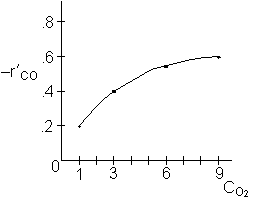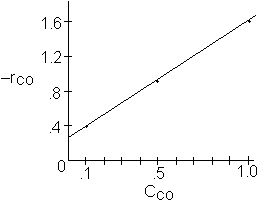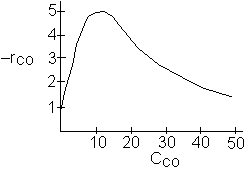Chapter 10: Catalysis and Catalytic Reactors
Finding the Mechanism
![]()
The following data were obtained for the oxidation of CO over a catalyst. All rates are initial rates
|
|
|
|
|
.020 |
0.01 |
1 |
|
.035 |
0.01 |
3 |
|
.049 |
.01 |
6 |
|
.060 |
.01 |
9 |
|
.196 |
.1 |
1 |
|
.384 |
.2 |
1 |
|
.902 |
.5 |
1 |
|
1.653 |
1 |
1 |
|
4.44 |
5 |
1 |
|
5.00 |
10 |
1 |
|
4.44 |
20 |
1 |
|
2.77 |
50 |
1 |
The initial rate was found to be independent of CO2.
a) Suggest a rate law consistent with the data
Hint 1 Sketch![]() versus CO2.
versus CO2.
Hint 2 Sketch![]() versus CCO
at low concentration.
versus CCO
at low concentration.
Hint 3 Sketch![]() versus CCO
at high concentration.
versus CCO
at high concentration.
Full Solution What is the rate law?
b) Suggest mechanisms consistent with the rate law
Hint 1 What do the trends suggest?
Hint 2 What is the mechanism?
Hint 1
Use only the data points for which the concentration of CO is the same.



![]()
Hint 2: Low concentration
For constant CO2

We see at low concentration the
rate is linear in CO and![]()
Hint 3: High concentration

At high concentrations the rate decreases with increasing concentration
![]()
Full Solution: Part A
Combining

For fixed concentration of O2 and low concentration of CO and
![]()
![]()
![]()
High concentration
![]()

![]()
Consequently the rate law

Satisfies the data
Hint 1
From the denominator of the rate law, we see that CO is adsorbed and that O2 is either weakly adsorbed (KO2PO21/2 << 1) or not adsorbed at all.
The 1/2 order with respect to oxygen suggests dissociative adsorption.
Because the initial rate is independent of CO2, it is either not adsorbed on the surface or weakly adsorbed.
Hint 2
The following mechanism is consistent with the rate law
Molecular
Adsorption ![]()
![]()
Dissociative
Adsorption ![]()

Surface
Reaction ![]()
![]()
Full Solution: Part B
The following mechanism is consistent with the rate law
Molecular
Adsorption ![]()
![]()
Dissociative
Adsorption ![]()

Surface
Reaction ![]()
![]()
Assume surface reaction limits
![]()
1) ![]()
![]()
2) 
![]()
3) ![]()
4) ![]()

5) 
We see that oxygen is weakly
adsorbed (very small![]() ) such that
) such that![]()



